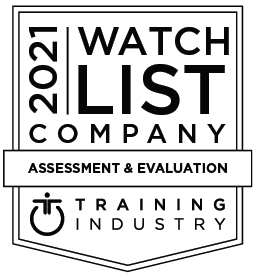Virtual skills aren’t just for remote workers.
Today, even colleagues in the same office building frequently communicate with one another by phone, email, chat, web meetings, and videoconferencing.
While the amount of work conducted virtually has increased, our readiness for virtual work hasn’t kept pace, according to this recent HBR article.
Most companies that offer some kind of virtual training tend to focus on software skills or company policies. Those are table stakes but do little to ensure communication effectiveness.
There’s one set of virtual skills that does make or break your ability to be effective: your delivery. This includes things like composure, intonation, energy, pausing, eliminating clutter words, etc.
Virtual settings magnify poor delivery skills. It’s the #1 reason why web meetings and webcasts have earned a notoriously bad rap.
Even great face-to-face communicators struggle in virtual environments.
To give you an example, one of our best trainers was recently on a short call with a potential client. He was being positioned as the trainer for an upcoming keynote event. After the call, the client said she didn’t think he had the “right energy” for their team and was there someone else we could recommend.
Surprising, right?
This trainer consistently scored the highest of marks and praise from clients for high stakes presentation sessions, but based on a very short call, during which the trainer thought he was doing well, the client made a judgment.
Therein lies the lesson: virtual and face-to-face dynamics are different.
Using your usual face-to-face delivery style in a virtual environment may not be enough, just as it wasn’t for our trainer. To be successful in a virtual environment, you have to adjust your delivery to take into account the unique challenges virtual settings present.
Have you ever participated in (or led) a virtual meeting that, rather than go as planned, fell prey to one of these all-too-common fates?
- Lacked focus
- Strayed from the agenda
- Got hijacked by a strong personality
- Was met with negativity from participants
- Fell on multitasking ears
The good news? You can do something about it.
When you’re communicating virtually—without the benefit of face-to-face contact and visual cues—it’s even more important to keep your cool and amplify your energy.
We believe anyone can learn how to do this and have put together the following guidelines to help.
Master your composure.
To sound and feel in control during a virtual meeting or call, you must keep your cool at all times, even (or especially) when things go wrong.
Maybe the technology isn’t working right, you’ve lost your place in your notes, or participants are unresponsive. Whatever happens, it’s important to maintain your credibility and composure.
Here are 3 ways to do just that:
-
Maintain Good Posture
- Use an engaged, open posture to feel more relaxed and confident.
- As simple as it sounds, it helps to have your feet flat on the floor and to not cross your legs.
- Sit straight and relaxed. If that’s not your habit, practice until you feel comfortable.
- Avoid shifting and rocking in your chair.
-
Use Pauses
- Use pauses to stay in control and punctuate your thoughts.
- Breathe to stay relaxed.
- Avoid rushing: pace yourself and enunciate clearly.
- Eliminate clutter words: um, ah, so, right, and.
-
Use Eye Contact
- Eye contact can help you feel more connected to your virtual participants, even if you can’t see each other.
- If using a camera, think of the camera as the person you’re talking to and speak to it as if you were having a face-to-face conversation.
- If not using a camera, find visual targets to focus on. Put your meeting notes or participant log in front of you, plus any supporting docs.
- Some people even put up photographs of participants and talk to those images.
Amplify your energy.
When you communicate virtually, with or without a camera, you’ll find that you need to amplify your energy beyond what may be comfortable for you in order to demonstrate your enthusiasm and commitment.
Here are 3 ways to do that:
-
Gesture Purposefully
- Use natural gestures to emphasize your thoughts and ideas.
- While participants can’t see your gestures, simple arm movements generate energy in your body that helps punctuate your sentences and vary the intonation of your voice.
- If you’re using a camera, gesture more slowly and deliberately.
- Avoid clasping your hands, playing with objects, or making other nervous movements.
-
Speak Clearly
- Keep in mind that without a camera, your voice must carry the conversation.
- Avoid jargon, slang, and acronyms.
- Look and sound as if you’re totally engaged and glad to be there.
- Keep your voice level up; don’t trail off at the end of your sentences.
-
Project Conviction
- Use your voice and language to demonstrate confidence and emphasize importance or urgency.
- Vary your vocal volume, speed, and pitch to match your content.
- “Paint” pictures with your words.
- Be assertive and avoid tentative language, like hopefully or maybe.
Better virtual delivery skills make for a better experience all around—for you and your colleagues or customers.
Put virtual communication skills into practice and see the difference in the results you get.
When you master your composure and amplify your energy online or on the phone, you’re better able to:
- Keep your listener’s attention.
- Elicit their feedback and involvement.
- Accomplish your goals.
Virtual skills are a must-have for every professional.
To increase your organization’s virtual effectiveness, go beyond training people on how to use tools or implement company policy. Instead, give them the skills to clearly convey their message with the credibility and conviction needed to make progress happen.
Want to improve your virtual skills? There’s an app for that.
Mandel has partnered with Orai to develop an AI-powered, always-on speech coach accessible from your mobile device. Practice your speaking skills and get instant feedback on pacing, energy, clutter words, and more. Use it to prepare for high-stakes communications—from webcasts and webinars to keynotes and executive presentations. Learn more and download the app here.










